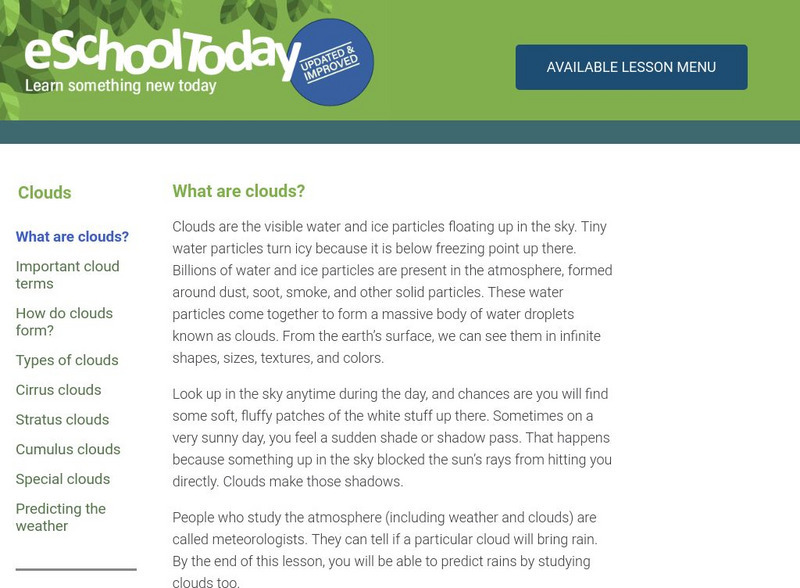Curated OER
Weather Folklore
For this weather worksheet, students decode the given "weather lore" using the code provided. Students must decode 7 different statements.
Curated OER
How Do Clouds Affect Radiative Energy
Students graph the upwelling and downwelling of shortwave radiation. They create a data table with the information. Students compute the Watts per square meter. They discuss their results and whether or not cloud type affects daily...
Curated OER
A Cloud In The Hand
Students investigate the scientific concept of forming clouds. The use simple materials to simulate the formation. This creates a powerful visual for students to make cognitive connections. They make observations and record them in a lab...
Curated OER
Weather: Clouds
First graders discover how clouds are formed and how they affect weather. After being read a book, they place air into a Ziploc bag and place it in the freezer. They discuss the results and take a walk outside to observe real clouds.
Curated OER
Scientific Literacy - Lightning
Students investigate how radar can be used to determine the lightning potential of a cloud. Several readings are provided about the research conducted by Dr. Rob Cifelli. The scientific material is summarized in this lesson.
Curated OER
Clouds
Pupils explore the characteristics of clouds, their formation, symbols used in their identification, and the relationship of clouds to weather. The lesson focuses on how they are formed and their classification.
Curated OER
Cloud Formation
Students engage in a lab which reinforces the concepts of condensation, dew point, humidity, pressure, and the process of cloud formation. After the lab, students answer questions about cloud formation imbedded in the plan.
Curated OER
Cruising Through Clouds
Learners listen to information presented about clouds. Then students determine the three main types of clouds, and how they are alike and different. They draw cirrus, stratus and cumulus clouds.
Curated OER
Clouds
Second graders explore how to identify cloud types by observing clouds. They record data and have fun by applying newly acquired knowledge throughout the curriculum.
Curated OER
Clouds and Solar Radiation
Students examine how clouds affect incoming solar radiation. They compare and contrast satellite images and incoming solar radiation measurements as methods to provide information about clouds.
Curated OER
Cloud Painting
Students explore clouds and abstract thinking through painting. This lesson uses higher thinking skills and encourages self expression.
eSchool Today
E School Today: Your Revision Notes on Clouds
Learn all about clouds, how they form, the different types, and how they can be used to predict the weather.
Science Education Resource Center at Carleton College
Serc: Investigating Three Main Ingredients Needed to Create a Cloud in a Bottle
In the science lab, learners will create and observe the conditions necessary to make a cloud in a bottle.
Globe
The Globe Program: Cloud Protocols [Pdf]
A lesson plan for students to observe ten types of clouds including contrails. Lesson plan includes teacher information as well as student data sheet.
CK-12 Foundation
Ck 12: Physical Science: Deposition
[Free Registration/Login may be required to access all resource tools.] Definition of deposition and examples of deposition in nature.
Enchanted Learning
Enchanted Learning: Zoom Astronomy: The Earth's Atmosphere
Site provides information on the Earth's atmosphere as well as offers additional information about Earth.
University Corporation for Atmospheric Research
Ucar: Weather Images
Photos, diagrams, and other images related to weather.
University Corporation for Atmospheric Research
Ucar: Clouds Images
Photos of various types of clouds and diagrams to help you understand clouds.
University Corporation for Atmospheric Research
Ucar: Cloud Sorting Game
Sort photos of clouds by altitude, by composition, and into groups based on whether they are smooth or turbulent.
Ducksters
Ducksters: Earth Science for Kids: Weather: Clouds
Kids learn about clouds including how they form, levels, fun facts, and types of clouds such as cirrus, cumulus, and stratus.
















![The Globe Program: Cloud Protocols [Pdf] Lesson Plan The Globe Program: Cloud Protocols [Pdf] Lesson Plan](https://static.lp.lexp.cloud/images/attachment_defaults/resource/large/FPO-knovation.png)


